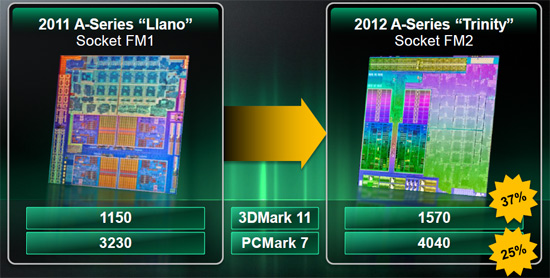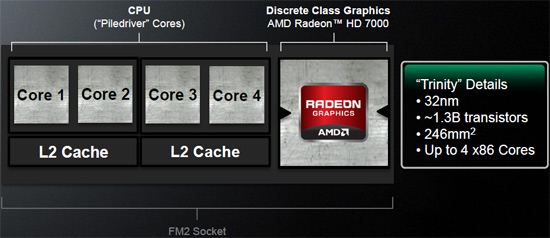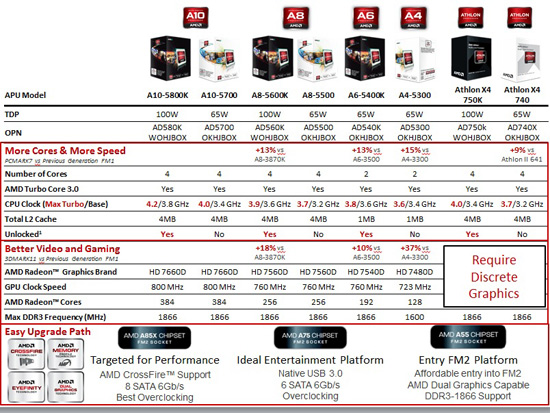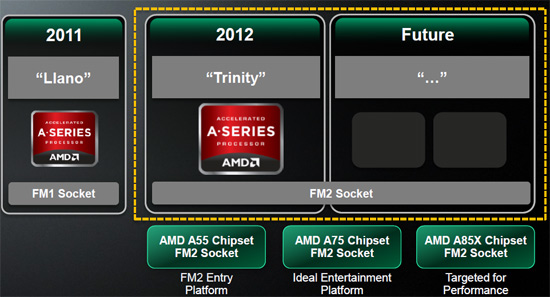AMD A10-5800K Trinity Desktop APU w/ Socket FM2 Performance Preview
2012 A-Series APUs Arrive – Trinity w/ Socket FM2
Some might say that the desktop PC market is stagnant, but AMD and Intel have been releasing some very interesting processors that have some serious bang for the buck. In January 2011 AMD released Accelerated Processing Units (APUs), which are processors that have both x86 CPU cores and graphics cores on one chip. The first generation of APUs were called the A-Series ‘Llano’ APU family and they raised the bar when it comes to overall performance on todays mainstream PCs. AMD has long been considered the value play when it comes to building a PC and the company does not want that to change anytime soon.

Today, AMD is allowing us a preview the second generation AMD A-Series ‘Trinity’ APU family that they believe will make the desktop experience even better. Along with the second generation of APU comes a new processor socket and an updated chipset as well, so AMD has been pretty busy lately.

AMDs new ‘Trinity’ APU are still manufactured by GlobalFoundries’ on the 32 nm SOI process process, but is based on the newer Piledriver x86 architecture. This is the same architecture that is used on high-end Bulldozer processors, so we finally see this technology becoming available in more affordable processors. The Trinity APU has roughly 1.3 billion transistors and is 246mm2.
AMD also improved the graphics architecture in Trinity and rather than using the VLIW5 arrangement found in Llano, AMD went when the VLIW4 design. AMD used VLIW5 in Radeon HD 6800 and older GPUs and used VLIW4 in the Radeon HD 6900 series cards. All of the newer Radeon HD 7000 series cards use Graphics Core Next (GCN) designs, so expect to see VLIW4 being short lived in APUs as well.

AMD is announcing eight new APUs today and while we can’t mention pricing, we can show and talk about all the other details. The AMD A10-5800K will be AMDs flagship processor and that will be the one we will be using today for testing. This processor has a 3.8Ghz base clock and can go up to 4.2GHz thanks to AMD TurboCore 3.0 technology. Don’t expect it to be at 4.2GHz for long though as it has many intermediate P-states and is bouncing all over the place for power savings. The AMD A10-5800K also has 4MB of L2 cache and is a ‘K’ part, which means it is unlocked for easier overclocking. On the graphics side of things, it has the AMD Radeon HD 7660D GPU with 384 cores running up to 800MHz.
New AMD Desktop Processors:
- AMD A10-5800K w/ AMD Radeon HD 7660D Graphics
- AMD A10-5700 w/ AMD Radeon HD 7660D Graphics
- AMD A8-5600K w/ AMD Radeon HD 7560D Graphics
- AMD A8-5500 w/AMD Radeon HD 7560D Graphics
- AMD A6-5400k w/ AMD Radeon HD 7540D Graphics
- AMD A6-5300 w/ AMD Radeon HD 7480D Graphics
- AMD Athlon X4 750K
- AMD Athlon X4 740

The one bad thing about the new APUs is that they can only be used on motherboards with the new FM2 processor Socket. AMD had to change the pin count from Llano to Trinity and that royally screws all the early APU adopters. AMD didn’t originally expect this change and understands that it is a bad situation. The AMD A75 chipset is compatible with the new Trinity APU’s, so you will see ‘new’ AMD A75 based boards coming out alongside the new AMD A85 chipset. The AMD A85 chipset adds two more SATA III 6Gbps ports, improved overclocking features and enhanced AMD CrossFireX support. AMD said that the next generation APU will work with FM2 sockets, so if you buy a board for Trinity then you’ll have an upgrade path next year.
Let’s take a look at the A10-5800K APU and the A85 chipset based board that we will be using for testing!

Comments are closed.